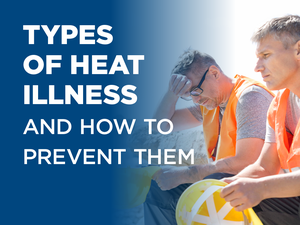- Home
- Loss Control
- Loss Control Insights
- Types of Heat Illness and How to Prevent Them
Summer is a great time for outdoor work, but when temperatures get extreme, it can cause dangerous conditions. Excessive heat, high humidity and sun exposure can lead to sunburn, dehydration, heat cramps, heat exhaustion and heat stroke. It’s essential that companies have policies and training in place to keep workers safe during hot weather.
Preventing Heat Illness
The foundation of any good heat safety program is the WRS method, which stands for water, rest and shade.
- Water—Stay hydrated with cool water or non-caffeinated or caffeine-free electrolytic beverages. Water intake is adequate when urine is clear or light yellow. When the desire to urinate is less than twice per day and/or you are producing a dark yellow urine, you may be dehydrated.
- Rest—Know your limits and take time to adequately rest and recover between tasks. Management should rearrange schedules to accommodate weather conditions when possible. Or consider rotating job functions among workers to minimize overexertion and heat exposure.
- Shade—Spending 15 minutes in a shaded or cool area can significantly drop your body’s core temperature. If no shade is present, consider setting up a pop-up shelter or having an indoor cool down area. Use a cooling fan whenever possible but avoid repeatedly going in and out of air conditioned areas as it will make it harder to adjust to the heat.
Now that you know the key strategies, here are some additional tips for preventing heat illness.
- Wear protective clothing
Light-colored, loose-fitting, breathable clothing made from natural materials will help protect workers from the heat and sun. Glasses with UV protection, sunscreen and brimmed hard hats can also help keep workers safe. - Be extra cautious with protective gear
Working outside when the temperature and humidity are high is dangerous enough—add protective gear and your risk of heat illness increases. It can be difficult for air to circulate through protective garments, so take extra caution when wearing them. - Take it slow
Gradually build up to heavy work so workers’ bodies have time to acclimate. In one OSHA report, nearly 80% of heat-related illnesses involved workers who had been on the job for four or fewer days. And, if possible, do the hardest work during the coolest time of the day. - Choose lunch carefully
Advise your workers about how to eat for the extreme temperatures: lunches that include fruits, vegetables and salads. Recommend eating breakfasts that high in protein in order to avoid overeating at lunch. - Regularly monitor the weather forecast
Check the weather forecast every morning to know what to expect that day. If you can rearrange your team’s schedule to accommodate weather conditions, do so. Plan outdoor tasks in the morning before the onset of intense heat and work indoor tasks into your afternoon schedule.
Heat Illness Symptoms
A key step in preventing heat illness is being able to recognize the symptoms. Heat-related illnesses can cause confusion and poor judgment, so employees may not realize they are getting sick. Monitor your workers during extreme heat and make sure all employees know the systems of heat-induced illnesses so they can help keep an eye on each other:
- Symptoms of Heat Stroke
- High body temperature
- Hot, red, dry or damp skin
- Fast, strong pulse
- Headache
- Dizziness
- Nausea
- Confusion
- Losing consciousness
- Symptoms of Heat Exhaustion
- Heavy sweating
- Cold pale, clammy skin
- Fast, weak pulse
- Nausea or vomiting
- Muscle cramps
- Tiredness or weakness
- Dizziness
- Headache
- Fainting
Symptoms of Heat Cramps
- Heavy sweating during intense exercise
- Muscle pain or spasms
What To Do If Heat Illness Strikes
If you or an employee notice the symptoms of severe heat illness (confusion, vomiting or loss of consciousness), it’s critical that you act immediately.
- Call 911
- Move the person to a cooler location
Do your best to reduce the person’s body temperature by applying cool, wet cloths or wetting their clothing
For less severe symptoms, OSHA recommends:
- Stopping physical activity and moving to a cool place
- Loosening clothes
- Applying cool, wet cloths
- Sipping water or a sports drink
Heat Illness FAQ
EMC Industrial Hygienist Jordon Curzon answers common questions about heat illness. Read the FAQ.
Get in touch
Need help? We’re here for you! Whether you have questions or need personalized assistance, your local office is ready to support you.
Loss Control Insights
Stay informed with the latest news and receive actionable safety tips, all carefully curated by our team of experts.
